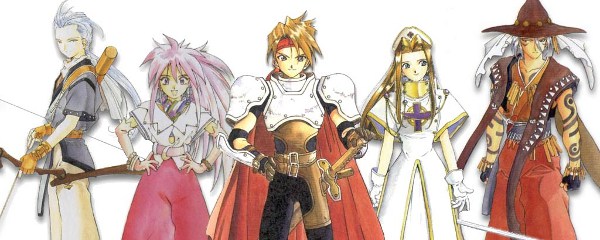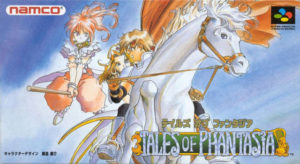
(This review may contain spoilers for the following games. If you have not played the game before, please exercise caution before viewing this post. You have been warned.)
The Tales series has always been one of my favorite RPG franchises, even with the lackluster titles as of late. That’s not to say of the newer titles are bad, but the series recently begun traversing a wildly different path which deviates from what made the series great to begin with. I’m greatly looking forward to playing Tales of Berseria, but in the mean time, let us look at a what started the franchise, a fantasy adventure which travels across centuries, Tales of Phantasia
Story
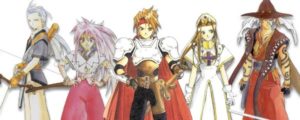
Tales of Phantasia tells the story of Cress Albane, Mint Adenade, Claus F. Lester, and Arche Klein, in their quest to defeat Dhaos and save the Great Tree from dying in the process. Being the first game in the series, the story does not surprise and take as many chances as the series can today. In addition, Tales of Phantasia was originally a novel, titled Tale Fantasia. However, the conversion of mediums caused some issues in story, such as unnecessary plot holes. I cannot say the plot moved me, but I can say that I thoroughly enjoyed the story and I was attached to the characters and their interactions. That enjoyment only increased once you get the final party member, Chester Burklight, and the party generates an atmosphere that many later Tales games would attempt to recreate. Tales of Phantasia also only contains one major villain during its course, as opposed to future installments in the franchise which house many minor antagonists which leads up to the final endgame antagonist, whilst twisting the overarching plot along with numerous key elements. I can honestly say that Dhaos provides us with a convincing and interesting antagonist, with an actual motive to his madness. While common in the series now, this portrayal of the antagonist was almost unheard of, and can be considered a favorable twist to the battle of good vs. evil.
Tales of Phantasia contains some of the best interactions among characters in the series. The four main characters work well together, and create some amusing situations as a result. Chester, rather than detracting from the party’s charm, only adds to it with his personality and style. In addition, I really like the pairings in this game, with Cress and Mint being the great main romance, leaving the romance between Chester and Arche to flourish into a rather comical relationship. These elements during the story attached myself to the characters, and I truly felt invested in each character’s life.
Gameplay
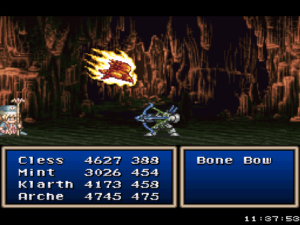
I’m not going to praise Tales of Phantasia for it’s fantastic gameplay, nor will I say it contains one of the best iterations of the Linear Motion Battle System (LMBS) in the series. However, when considered as a starting point in the series, the LMBS set a great base system for all future Tales games to expand and grow into new further developed versions of the battle system. In addition, Tales of Phantasia was developed by Wolf Team at Namco, which later split off into Namco Tales Studio and tri-Ace, creators of the Star Ocean series. This split can be seen by observing the Star Ocean games and witnessing the obvious similarities between the two; with such a similar style, they can feel interconnected at times! (It’s also interesting to note that Yoshiharu Gotanda, writer of Tale Fantasia, helped found tri-Ace in 1995).
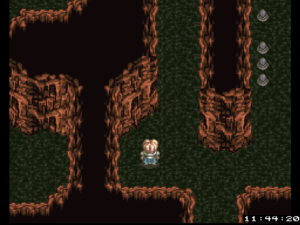
Tales of Phantasia‘s LMBS leaves the player on a 2D plane, fighting the enemy in real time. The player can use skills (which cost TP), attack normally, or guard. By attacking normally, Cress will run up to the enemy (if he is not already near the enemy) and attack. By pressing ‘Up,’ one can tell Cress to stab instead of swing, which uses a different stat value for attack on certain weapons. Cress also has two different styles for skills. Instead of assigning each skill to a different button, four skills can be assigned to the skill button, which will allow Cress to use a skill depending on his distance from the enemy and the dependency of the ‘Up” button state when pressing the skill button. While I like this original idea, it’s easy to see why the developers changed it. One major issue with this design choice stems from the skills themselves. Each skill consists of a type designating whether the skill is long range or short range, with short range skills lacking toward the end game. Many useful skills end up neglected due to the limitation of allowing only two long range skills, while two less useful skills lie in the short range skill list.
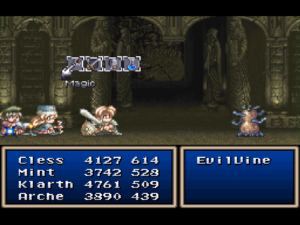
In addition, one can also use the ‘Y’ button to bring up the magic menu (this will allow one to tell a party member to use a certain spell), use an item, or change formation. Unfortunately, while this feature can be greatly appreciated, it also highlights the limitations of the hardware. The player can only use items and command spells when there is not a spell being used at the moment. Due to the battle freezing to show the spell being cast at that moment, the player loses all control for those few seconds. While the battle freezes, it also moves to show the character casting the spell; this would not be an issue, except for the fact that the screen moves before the gameplay freezes. I did not suffer any casualties while playing, but this became a noticeable issue during the game. Also, the player cannot change equipment in the battle menu, so if one attempts to fight an enemy with ice resist using an ice weapon, they must leave the battle to the party or run, if that is an option. As for the battles throughout the story, they played out well, containing a fair difficulty throughout the game, and only a couple circumstances arose where I was unhappy with the battle system (I’m looking at you, Unicorn Sky Battles!).
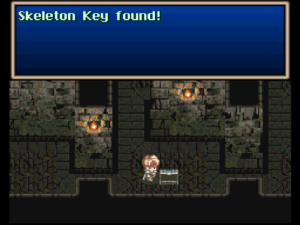
The first few games in the Tales series suffer from an issue I’m glad the developers gradually moved away from, and that issue can be defined ‘Random Battles.’ Of course, being a SNES title, I would not expect that the game contains encounters of the same caliber as Symphonia or Abyss, but the problem lies in the addition of puzzle elements to the dungeons. There is nothing worse than attempting to solve a puzzle and running into an encounter in the middle of the completion of the puzzle. The element of random battles completely removes the player from the mindset of puzzle solving and detracts from the task at hand. In certain rooms, there should be a switch to turn off random battles, as they came up unnecessarily numerous times in the middle of a puzzle. Holy Bottles did not help either, as they only reduced the encounter rate, rather than remove the rate completely. (Volt’s Cavern was definitely the worst perpetrator of this, with movement puzzles and random battles…)
Also, my last complaint lies in the last party member, Chester. While I think having a decent number of party members adds value to the party, giving the player a low-level character in the middle of the game feels odd. Why would anyone be driven to use Chester if he’s given at such a low level? He cannot learn skills, and he’s presented as a less than useful character. While I love Chester in the story, in battle, he’s an easy pass.
Sound
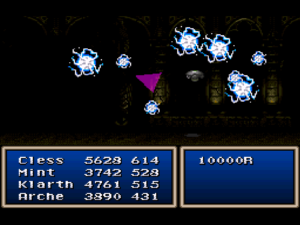
Tales of Phantasia contains a fantastic soundtrack; many songs would later be remixed and used in remakes of the game, along with the pseudo-sequel, Tales of Symphonia. Fighting of the Spirit, one of the most notable tracks in the series, derives from this game, and the song can be described as pure orgasmic. Of course, the one song can not make up for the rest of the soundtrack, and it hardly needs to do so. The entire soundtrack contains songs fitting of the area, and allows the player to become immersed in the world of Aselia. In addition, Phantasia contains a kickass theme song, titled “The Dream Will Not Die” by Yukari Yoshida. For a SNES title, the fact that the game could contain a theme with lyrics speaks volumes about the development team, and the love they poured into this game. Tales of Phantasia certainly exceeded in the sound department, and would be a sign of things to come in the series.
Presentation
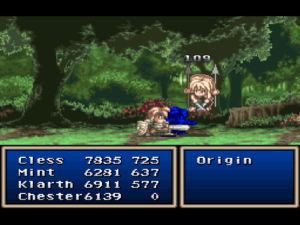
Tales of Phantasia provides a great starting point for the series, but it still contains some noticeable flaws. For example, death does not cure poison, which actually baffled me at one point, as it should be assumed that death would cure any status ailment, considering death overrides all status ailments. Of course, with the examples mentioned previously, such as skill freezing and limitations of useful skills, there were a lot of nitpicks to sift through this game. However, I would not consider it a bad game. The game contains numerous features that would become staples in the series, and even has a vocal theme song! In fact, the game went on to be released numerous times for different consoles, adding features and changes that the SNES version did not contain.
New Versions
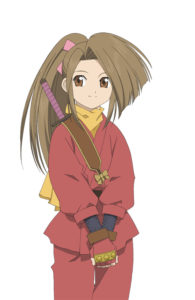
I’ll be briefly discussing the PSX port of the game, and the GameBoy Advance port of the game. In 1998, Namco released the PlayStation port of Tales of Phantasia, which ultimately used a revised Destiny battle system and contained many changes to the story and gameplay elements. For example, a prominent feature in Phantasia was the food sack one could use to store food to heal up after each battle. This was changed to cooking in the port, ultimately adding a new dimension to the game. In addition to food, by using a revised LMBS, many of the issues I brought up in battle cease to exist. Equipment can be changed, and while spells still stop the battle, the screen doesn’t move away from the player too quickly to cause cheap damage from the enemy. The port also added a new character, Suzu Fujibayashi. While she was present in the SNES version, she only became playable in the PlayStation port and beyond, further extending the possibilities of the game and replayability. I would consider this version to be the go-to version, especially since a fan translation exists and it’s readily available for all.
The GameBoyAdvance port actually fails to fix many of the issues of the SNES version, and in fact, creates its own with the limited resolution of the screen. The Advance manages to wash out many of the colors in the game, the soundtrack lacks the impact of the SNES version, and the localized version does not contain the main theme, “The Dream Will Not Die.” A lackluster port, but unfortunately, the only official version to leave Japan, which is a shame.
Final
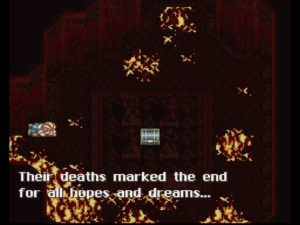
Hell, I had a lot more about this game I wanted to say than I thought. However, Tales of Phantasia is an awesome game, and one that should be picked up by any Tales fan. It allows one to see where the series first started, and provides insight to what going to the roots of the series would mean for the future. Of course, I would highly recommend that one should pick up the PSX port of the game, unless the SNES version appeals more due to its age, and legacy of being the one that started it all. In all, check this game out; it contains an entertaining story and a fun cast of characters, with a intriguing battle system to boot.
-Ace
